| |
MANGE - Mange is a contagious skin disease caused
by one of a variety of mites that live on the animal. It is transmitted
by direct contact with diseased animals or indirectly by contaminated
quarters or even dust baths. The mite's entire life cycle is on the
animal and two to three weeks may be required to complete the life
cycle.
The three most common kinds of mites are Sarcoptes, Chorioptes, and
Psoroptes. These mites all look very similar under the microscope.
Sarcoptic mange is caused specifically by Sarcoptes scabeii.
The mite burrows into the outer layer of skin in areas without much hair
such as the legs, ears, and belly. The area develops bald spots,
flaking, crusts and the skin may become thickened and leather-like as
the disease continues. The mites may cause intense itching. Your
veterinarian can confirm the mites with a skin scraping. Treatment is
Ivomec injected SQ, 1cc per 100 lbs. (Source - Dr. Norman Evans, DVM)
Chorioptes mites
live their entire three week life cycle on the surface of the skin where
they feed on dead cells and dander. This mite is not contagious to
humans. Symptoms can be spotty hair loss and thickened tissues and
appear to be itchy. Most common between the toes. Effective
treatment is fipronil (Frontline spray) by Merial. This kills the
mites it contacts within two hours and lasts up to one month. For
best results, give repeated treatments of the affected areas every three
weeks for a total of four treatments. See more info
here.
Another treatment may be Lime Sulfur Dip. Mix 1 oz. Lime Sulfur
Dip with 32 oz. water and apply to areas. Wear rubber
gloves. A squirt bottle is suggested.
Mites, Mange & Treatments
(the following articles would also apply to
llamas)
ALPACA SKIN PROBLEMS:
THE MYTH, THE MITES, AND THE MUNGE
By Mike Safley
|
|
I
remember slowly bending over and grasping the front leg of a 6-month-old
white alpaca: It was 1994 and I was trimming toenails. An immediate
feeling of panic leapt into my chest as I discovered a bloody puss
between her toes: Could this be foot and mouth disease, I naively
wondered? I immediately called my vet, Dr Jerilynn Booher, and we
pondered the problem. The female in question also had infected ears,
hair loss, and small, puss-infused pimples on her nose. (It was not foot
and mouth disease.) |
|
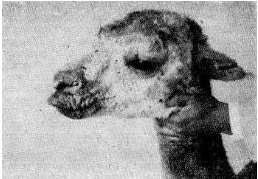
Ex. A |
I made a trip to Peru shortly after my discovery
of the puss-infected toes and as I was browsing through the used
book section in a small bookstore off the main square in
Arequipa, I found a slim, dog-eared volume on Andean livestock
husbandry: Instituto Veterinario de Investigaciones
Tropicales Y De Altura (Ivita), edited by Dr. Manuel Moro S.
and Dr. Saul Fernández Baca, and published in 1966.
I opened the book to a page that contained the photograph
seen (Ex. A), which pictured a more advanced condition of
what I had discovered on my female.
|
| After I returned to the U.S.and had the
text describing the symptoms translated from Spanish to
English, I realized the condition was the result of skin
mites. I had stumbled onto the catalyst for a
comprehensive Camelid skin cure that I call “witches
brew”.
The
Symptoms
The
skin condition in question is familiar to most alpaca
owners—loss of hair on the nose and face, loss of hair at the
ankles (Ex. C), or scabby skin in the hairless areas on the
belly. This is accompanied by varying degrees of red thickened
skin and puss-filled pimples in the hair loss areas and crusty
ears with gobs of black, waxy material in the ear canal. (Not
all symptoms appear at the beginning, in advanced cases this ear
condition can turn into a foul-smelling, puss-filled infection.)
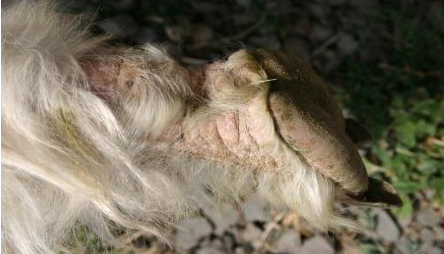
Ex. C Hair loss on ankles
|
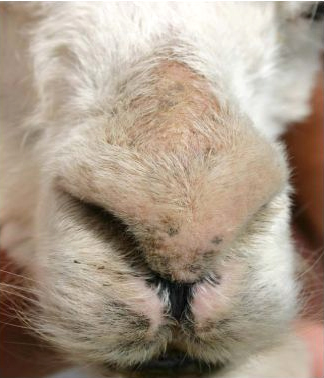
Ex. B Hair loss on face |
|
The
Myth
I
am constantly inspecting alpacas at shows and seminars around
the country and the world. The most common problems that I
observe are funky skin conditions with the symptoms that I
described above. If the owners have noticed the problem or
spoken with their veterinarians about it, they most often tell
me that it has been diagnosed as “zinc deficiency”. Some say
they believe it is due to sunburn. Few, if any, have found an
effective cure for the conditions they describe.
There
is some basis to believe that these problems are attributable to
the lack of zinc in an animal’s diet. The camelid medical
books are full of descriptions—thick skin, hair loss, and
pussy pimples—which they attribute to zinc responsive
dermatitis (The Veterinary Clinics of North America Food
Animal Practice, “Update on Llama Dermatology” by Rod A.
W. Rosychuk, July, 1994, pg. 232, 233; Medicine and Surgery
of South American Camelids, Murray E. Fowler, 1989, pg. 26; The
Complete Alpaca Book, 2003, pg. 194.) However, as Norm Evans
says in The Alpaca Field Manual, 2003, pg. 45, “I
question that every skin problem in alpacas is a zinc responsive
dermatitis. How many severe skin problems respond to zinc? I
suggest five to ten percent.” My veterinarian, Dr. Paul Jones,
agrees, saying he believes that “less than 5% of alpaca skin
problems are related to zinc deficiency.” In fact, Dr. Evans
believes that straight zinc oxide in the diet can “actually
aggravate skin problems.”
The
myth that suggests these skin problems are a result of sunburn
is even harder to understand. It defies logic that animals that
were domesticated under cloudless skies, over a shadeless plain,
under a sun that is 15,000 feet closer to their face than almost
any other large mammal on earth, would not have acclimated to
the sun. I found, after a fairly extensive review of the
existing literature on the subject, only one reference to
sunburn being the root cause of camelid skin problems. I must
say, upon reading the following quote, I had to smile.
“Therapy for actinic dermatitis usually is not necessary,
unless the condition is severe. Consideration should be given to
sun restriction (especially between the hours of 10:00 am to
4:00 pm, topical sunscreens, and, possibly, glucocorticoid
administration” (The Veterinary clinics of North America:
Update on Llama Medicine, July 1994, pg. 229.)
(Upon
reading the above quote, I did not know whether to call PETA—People
for the Ethical Treatment of Animals—and report the llama
owners who neglected to slather their animals with suntan lotion
or to contact the Quechua herders in the mountains of Peru to
alert them to the wonders of New World medicine.)
But
enough of the myths. There are accurate diagnoses of these skin
maladies: mites and munge.
The
Mites
The
primary culprits in most problem skin cases are mites. There are
three kinds of these critters that cause the majority of
symptoms: Sacroptes scabii (scabies), chorioptic, and psoroptes.
(See Medicine and Surgery of South American Camelids by
Murray E. Fowler, 1989, pg. 205-210.) Before I move on, here is
a brief description of these little buggers:
1.
Sarcoptes are round, fat mites with short legs who copulate on
the surface of the skin, after which, the female burrows under
the skin and lays her eggs in the tunnel she creates. These
mites are often found on the alpacas lower legs, belly and
tail but they can range over the entire animal.
2. Chorioptic mites are more elongated than the sarcoptes
and they chew on the skin rather than burrowing. These mites
are less common and do not cause as severe of a reaction as
the sarcoptes.The chorioptic mites live entirely on the
surface of the skin and are often found between the toes, in
the ears, on the face and over the body. In Oregon the most
common mite is the chorioptic.
3.Psoroptic mites: These oval shaped bloodsuckers live on
the surface of the skin. There is some confusion as to
whether these mites even occur on alpacas in the United
States. The Veterinary Clinics of North America, Food
Animal Practice, March 1989, pg. 223, reports that
psoroptic mites have not been positively identified in
llamas and alpacas in the United States, although they are a
reportable disease. However, Murray Fowler, in Camelid
and Surgery of South American Camelids, pg. 209 says
he has diagnosed this mite in one American llama. The
Complete Alpaca Book, edited by Eric Hoffman reports
that the psoroptic mite is the common cause of ear mange in
alpaca (pg. 426). It appears that the information in The
Complete Alpaca Book is in error.
|
| All
of the above mites bite and suck, leaving behind a trail of red,
itching, thickened skin that often creates puss pockets similar
to a mild case of teenage acne. Many alpacas will have mites in
their ears, which they will drop to the side of their head and
scratch with their hind foot. Always check the inside of the ear
to see if a black waxy substance is present (this condition can
also be the result of ear ticks). This material is mite or tick
feces and indicates a need for treatment. As bad as this
condition looks, it can be cured in a fairly straight-forward
fashion. But first we need to march on to the munge. |
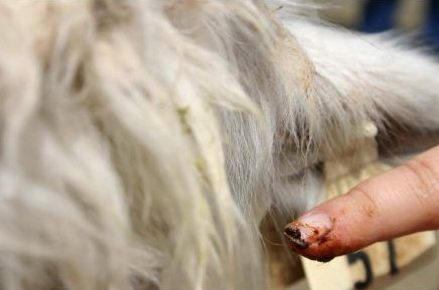
Ex. D Mites in the ear |
|
The Munge
Ideopathic
Nasal/Perioral Hyperkeratoxic Dermatitis, or Munge, might also
be the culprit of the above symptoms. Although alpacas at any
age are susceptible to the munge, it is most common in animals
four months to two years of age. The cause is unknown. It
resembles a viral disease in sheep and goats commonly called
“sore mouth” or “scabby mouth”. However, no particular
virus has been identified as the cause. The condition may be the
result of immunodeficiency, bacterial infection, fungal
infection or constant contact with an irritant like wet grass.
Munge
lesions may resemble mite lesions but most commonly affect the
lips and nose. The lesions include thickening and cracking of
the skin at the corners of the mouth which leads to crusty
scales of the lips and nose.
The Diagnosis
The
diagnosis for the presence of mites and the identity of which
species is present, can be made by your veterinarian from a skin
scraping.
The Cure
Whatever
the cause, I have been successfully treating all of the above
symptoms for years with a concoction I call “witches brew “.
This solution was conjured up by Dr. Jerilynn Booher shortly
after I returned from Peru with the book I found in Arequipa.
The recipe follows:
Witches Brew Recipe
Ingredients:
2/3
pint mineral oil
1/5
pint DMSO
8
ml Ivermectin
5
cc Gentamycin (50 mg per ml)
Directions
The
“brew” needs to be applied to the affected area every three
days for at least 15 days, maybe more. Make sure that you use
rubber gloves when you are applying the mixture. At the
beginning of the course of treatment, Dr. Jones recommends an
injection of Ivermectin followed by another 15 days later. In
addition, I have had a lot of success in curing ear mites by
infusing each ear with ½ cc of Ivermectin at the beginning of
treatment.
Dr.
Norm Evans recommended a similar solution in his 2003 book, The
Alpaca Field Manual, which he calls “Camelid Skin Mix”.
My vet, Dr. Paul Jones, decided that my name for the stuff,
“Witches Brew”, was not particularly professional, and he
prescribes the same ingredients using the name, “Camelid Skin
Solution”.
This
is how the ingredients interact to affect a cure: The DMSO
delivers the Ivermectin through the crusty skin; the mineral oil
holds the solution in place; and the Gentamycin acts as an
antibiotic and clears up the infections that follow the mites.
Please note that I am not, nor do I intend to be giving
veterinarian advice here. You will need your veterinarian to
make the diagnosis, prescribe the treatment and mix the
solution.
I
have, on occasion, suggested that an alpaca breeder use this
formula and their veterinarian has said, after scraping the
skin, “There are no mites.” Or, they have insisted that the
problem is zinc deficiency. One breeder reported to me that his
veterinarian refused to make the solution available because the
ingredients would “not mix properly” and they separated.
When I shared this concern with Dr. Jones, he agreed, but said
that if you simply shook the solution before applying, the
problem would resolve itself. Ah, some things are just too
simple.
If
the sore mouth symptoms are really a virus or bacteria, a
solution of Nolvasan Scrub (applied to the infected area) might
help clear up the condition, but I would follow it with an
application of “witches brew” to be safe. In fact, it does
not hurt to scrub any affected skin area with Nolvasan before
applying the witches brew. You may also want to move your
alpacas to a clean pasture after treatment. The mites, or their
eggs could collect in the soil and then be picked up by
unaffected animals. In any case, I have found that the condition
is not widely communicable among herd mates.
I
have had many, many breeders thank me for recommending this
solution over the years. For whatever reason, this solution
works on munge and mites of every kind. In fact, in my
experience, it even cures zinc deficiency and sunburn! (Just
kidding, of course.)
Article By Mike Safley
|
|
Chorioptic Mites
and Mange
Symptoms, Life Cycle, & Treatment |
|
"Chorioptic Mites can be a real headache to the
llama/alpaca owners. Difficult to diagnose and even
more difficult to treat, this exasperating parasite can
masquerade as its cousin, Sarcoptic Mange, or hide out
under secondary fungal or bacterial infections.
Symptoms can be quite variable from one animal to another
further confusing the situations."
Read about Chorioptic Mites here
The Mighty Mite
- Info and Treatments
|
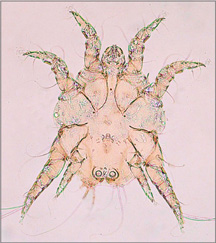 |
 |
 |
 |
Return To
Vet Info |
Return To
Llama Management |
Return To
Shagbark Ridge Llamas |
|
|





